The Tallahassee Museum invites you to explore our Adult Lecture Series highlighting educators and experiences in various fields from our region. Each lecture has been curated with you in mind. Previously recorded lectures will be uploaded to this section of our website for you to view! To register for future lectures or programs, visit our Events Calendar here.
April 18, 2024 Breaking the Mold Panel Discussion – Watch Now!
Embark on a journey with five seasoned museum professionals in this illuminating panel discussion discussing how museums have evolved over the past several decades. Hear their unique perspectives on navigating the evolving landscape of museums as they candidly share experiences, current challenges, and thought-provoking insights into the future of these cultural institutions.
Panel Moderator: Malinda Horton, Executive Director, Florida Association of Museums. Panelists: Grace B. Robinson, Executive Director, Gadsden Arts Center & Museum; Tiffany Baker, Museum Director, Florida Historic Capitol Museum; Alan Hanstein, Executive Director, Challenger Learning Center of Tallahassee; and Russell Daws, President/CEO, Tallahassee Museum. Presented in conjunction with the Florida Association of Museums and Visit Tallahassee.
May 2, 2024 “Tides of People in North Florida” by Dr. Elwood Carlson – Register Today
Embark on a historical journey guided by Dr. Elwood Carlson, the Charles Nam Professor Emeritus at FSU and a distinguished social demographer and researcher in migration. In this enlightening talk, delve into the narratives that define the individuals who shaped our region. Discover their origins, destinations, and the profound impact they left on our local history. Join us as we unveil the untold stories of the movement of people, connecting the dots to better understand the rich tapestry of our community’s past.
Free for members/admission for nonmembers. Must preregister online. Lecture is at the Tallahassee Museum at 5pm.
May 23, 2024 “Thank the Ocean for Every Other Breath You Take” by Dr. Bill Landing – Register Today
Dr. Bill Landing will be discussing the ocean as a garden, what grows where and why, explaining that the oxygen in every other breath you take comes from photosynthesis in the ocean and how the oceans play a huge role in the Earths carbon dioxide cycle.
Bill grew up in Burbank, CA and earned BS (1975) and Ph.D. (1983) degrees in Chemistry at UC Santa Cruz, where he was a founding member of the Nuclear
Whales Saxophone Orchestra. He earned an MS degree (1978) in chemical oceanography at the University of Washington in Seattle. After finishing his Ph.D. in 1983, Bill spent a year living in Gothenburg, Sweden where he studied the chemistry of Swedish and Norwegian fjords, while also learning to speak a little Swedish. Bill then joined the faculty in the Department of Oceanography at FSU in 1985 and retired in 2020 from the Department of Earth, Ocean, and Atmospheric Science, formed in 2010 via merger of the departments of Oceanography, Geological Sciences, and Meteorology. Bill taught a variety of courses at FSU, including Global Climate Change: its Scientific and Human Dimensions.
Free for members/admission for nonmembers. Must preregister online. Lecture is at the Tallahassee Museum at 5pm.
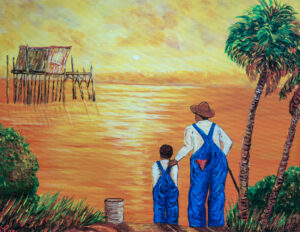
Ernest Lee, an award-winning artist from Raleigh, NC, who lived in North Central Florida for 20 years before his death in 2021, used his application of vigorous and colorful impasto brush work to fill his canvases with rich stories from across Florida’s history. Often called “Florida’s Van Gogh,” his love for painting and those he met along the way lives on in his works today. The Tallahassee Museum is excited to present a large body of his artwork from all phases of his career. This show will be open to the public from February 8th through July 9th, 2024.
To learn more about Ernest M. Lee, please visit ernestleeart.com.
Throughout the year, sugar cane is grown on the museum grounds. When it is time for harvest, the cane is cut by hand and pressed. The resulting liquid is poured into our kettle where it boils for several hours until it becomes a thicker consistency. To learn more about the sugar cane syrup process, watch our video below!
Join us for Fall Farm Day, the second Saturday of December, for a live Cane Syrup demonstration. Afterwards, cane syrup can be purchased from the Tallahassee Museum store.
The Museum is an invaluable resource to the community and the region because of its collections – the buildings, the animals and the artifacts. These collections preserve the region’s cultural and natural heritage, serve as a resource for loans and research, and offer visitors the opportunity to see animals in a natural setting that are no longer seen in the wild; to walk in buildings preserved from another time; and to enjoy the natural environment of the region. The Museum is the only museum in the area with a regional focus, and is unequalled in the state with its displays of vernacular architecture and live animals historically native to the region.
We invite you to explore the Tallahassee Museum’s more than 10,000 objects on-line!
Click here to view our online collections!
Brought to life in 1979, Jim Gary’s Twentieth Century Dinosaurs exhibition of large, colorful sculptures of dinosaurs, made from discarded automobile parts, began an amazing journey around the world. The exhibit traveled internationally to museums and universities; was used as sets for films, plays, and operas; was presented as exhibits for national auto shows and racing events; and was presented as landscape displays in the most elegant of botanical gardens, such as Longwood Gardens on the Pierre S. du Pont estate.
In 1993, the exhibition made its southeastern U.S. debut at the Tallahassee Museum and then continued on it world-wide tour. In 2006, internationally noted artist Jim Gary, died at the early age of 66. Later, the Jim Gary Foundation was established and efforts were pursued to preserve his memory, art and his Twentieth Century Dinosaurs exhibition. In 2011, the Foundation and Tallahassee Museum joined together to make the Museum the home of Jim Gary’s Twentieth Century Dinosaurs and showcase the largest restored collection of his dinosaur works.
Today, 21 exhibit pieces are featured at the Museum with some spanning as much as 43 feet in length and weigh up to 4,000 pounds. In Jim Gary’s Twentieth Century Dinosaurs, junkyard castaways get a second chance to function–transformed into graceful renditions of prehistoric creatures. They teach us lessons in art, science, technology and environmental education.
There is symmetry to the sculptures: the pieces making up each creature’s anatomy served similar functions in their previous roles as auto parts…upper and lower control arms are legs, rocker arms form vertebra, and brake shoes become feet!

Enjoy a quiet walk around the half-mile Nature Trail loop through a live oak tree hammock, a longleaf pine forest area under restoration, and along the picturesque cypress-edged Lake Hiawatha where you can observe seasonal wildflowers, a diversity of birdlife, colorful lizards, aquatic turtles, gopher tortoise burrows, and sinkholes. Visit the nearby McGowan Butterfly Garden, which provides food, water, and shelter for butterflies at each stage of their life cycle.
Experience the sights, sounds, and even the smells of each season as if you were living in the region’s rural 1880s. Walk among authentic farm buildings typical of the region and visit the mule, sheep, cow and other farm animals that contributed to the family’s livelihood. Stroll through the garden and see the corn, cotton, sugar cane, sweet potatoes, and other vegetables. Discover our rural industries—turpentining in the B.O. Wood Turpentine Commissary, blacksmithing, syrup-making, and milling. Discover the simple living and sleeping arrangements in the farmhouse or the cooking appliances and tools in the kitchen.
Farm animals include: cow, chickens, mules, pigs, sheep, goats, and geese.
Step back in time as you pass through the doors of our historic buildings reminiscent of southern living in years past – Bellevue plantation house, Bethlehem Missionary Baptist Church, Seaboard Airline Caboose, and Concord Schoolhouse. Each structure represents a community function through which the residents created a sense of purpose and sense of place for themselves and their children.
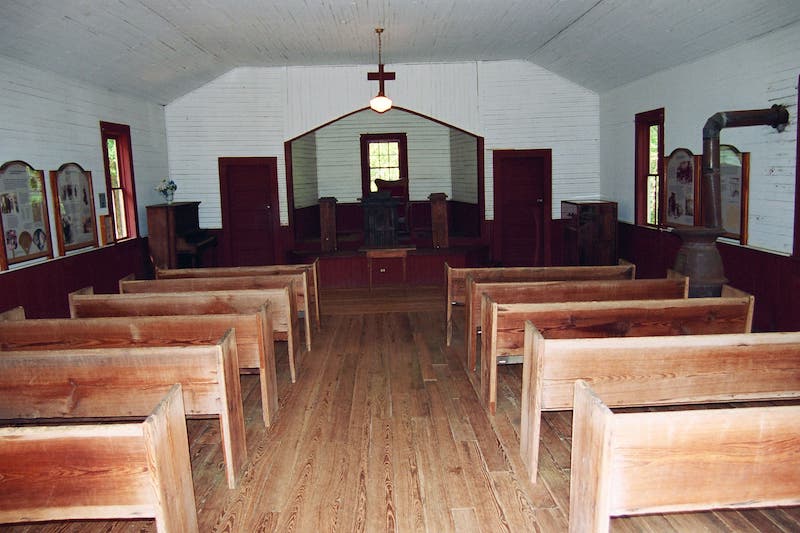 Bethlehem Missionary Baptist Church
Bethlehem Missionary Baptist Church
Established in 1851, Bethlehem Missionary Baptist was the first regularly organized black church in the State of Florida. In 1937, the congregation rebuilt the church using many of the original’s hand hewn timbers. The church was moved to the Tallahassee Museum and conserved as a Bicentennial project of Florida A & M University.
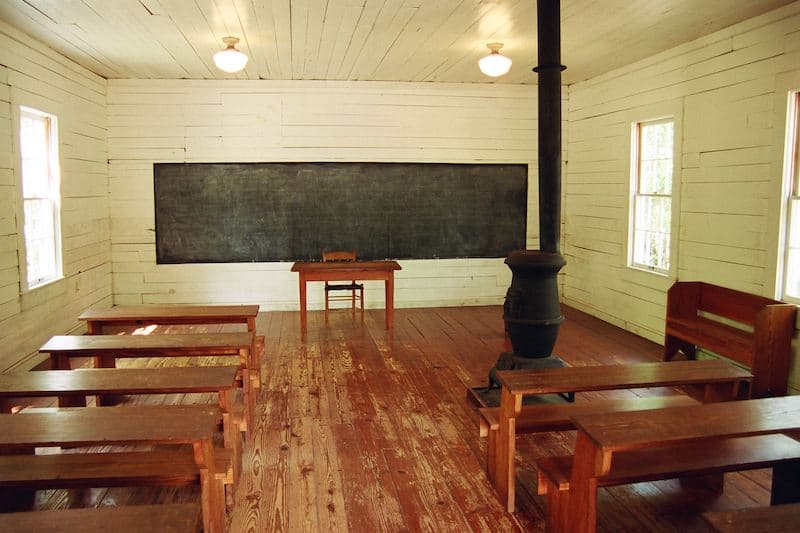
The Concord Schoolhouse
The Concord School came into existence in the late 1870s during Reconstruction when most southern communities, assisted by the Freedmen’s Bureau and the churches, established local schools for the children of former slaves. Originally located near the town of Miccosukee in Leon County, the school probably met in the Miccosukee A.M.E. church until this building was constructed in 1897.
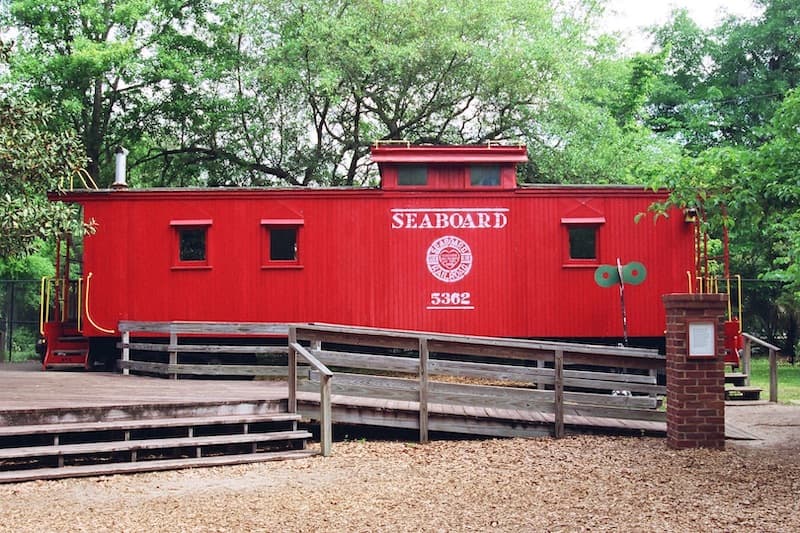
Seaboard Airline Caboose
From the era of Jim Crow through the Civil Rights movement, the Seaboard railroad crossed North Florida, supporting the growth of rural communities as it moved cash crops from field to market. Climb into the cupola and imagine life on the rails as a brakeman or conductor in the 1920s caboose!
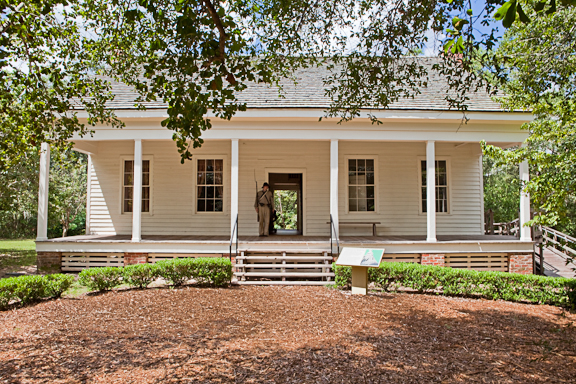
Bellevue Plantation
Catherine Murat, born a Virginian, moved to Florida with her parents where she met and married a Frenchman, Achille Murat, nephew of Napoleon. Related to George Washington by birth, she became a French princess by marriage. She lived at Bellevue from 1854 to 1867 and owned twenty-five enslaved descendants of Africans. The enslaved worked in the cotton fields, provided skilled labor, and tended to the cooking. Explore these contrasting plantation communities at Bellevue’s house, kitchen, and slave cabin.


Stroll the Museum’s elevated boardwalks and experience amazing living displays of native animals in their natural settings. Discover the rare Florida panther and red wolf, playful river otter, shy white-tailed deer, sleepy bears, tree climbing grey foxes, gobbling wild turkeys, and other native species. Observe and appreciate these ambassadors from the wild who live or once lived in the Big Bend region. These animals would not survive in the wild; they were either raised in captivity or have limited abilities as a result of injury.
Native animals on exhibit include:
- Red Wolf
- Black Bear
- North American River Otter
- White Tailed Deer
- Red Fox
- Grey Fox
- Striped Skunk
- Florida Panther
- Cougar
- Birds of Prey – Bald Eagle, Screech Owl, Great Horned Owl, Red Tailed Hawk
- Box Turtle
- Duck – Ringneck, Wood, Lesser Scaup
- Wild Turkey
- Bobcat
- Snakes – Eastern Indigo Snake, Florida Pine Snake, Gray Rat Snake, Red Rat Snake, Eastern King Snake, Banded Water Snakes, Eastern Diamondback Rattlesnake, Cottonmouth Snake
- Gopher Tortoise
- Yellow Bellied Slider Turtle
- Alligator Snapping Turtle

